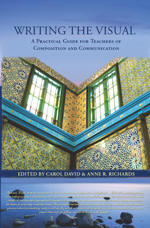|

The editors'
goal for such a text seems appropriate for classrooms today; no
doubt, teaching visual rhetoric is important. After all,
books about teaching visual rhetoric have been on the market for
some time now.
However,
some of the
examples provided by the authors in this text seem, at times, to
be obvious and do not, at other times, give enough credit to what students
and teachers already know about visual rhetoric. For
instance, David and Richards, the editors themselves, explain that "Students
are much more likely than we are to be immersed in visual
culture and to feel comfortable talking and writing about what
they see" (p. 5). Followed by a discussion on photography,
David and Richards then claim, somewhat contradictorily, that "Like the general public, students
typically are unaware of the rhetorical strategies that
photographers adopt when constructing, for example, angle,
lighting, and background" (p. 11). I'm not quite sure if
it is fair to characterize the general public and students in
this light. I've been amazed by what some of my own
students bring to discussions about visuals and find myself
learning just as much from them as they learn from me. I
guess that is why I appreciate the fact that, like myself,
Alyssa O'Brien does recognize that students are "leading the
way" in "producing multilayered argument projects that provide
diverse perspectives on visual images, innovative approaches to
the visual layout and content arrangement, and hypertextual
versions of traditional writing assignments that now use visual
rhetoric as a strategy of argument" (p. 185).
It seems, then, that
the essays in this collection are aimed at an
audience that is either just now realizing the importance of
incorporating visual rhetoric into writing and communication
classrooms or are new and need some further ideas for
instruction. This is particularly evident in the second
chapter of the book when Nancy Allen offers her arguments for
including instruction in visual rhetoric in the classroom.
Her arguments are old. For example, her suggestions that
mind maps, storyboards, and sketches are helpful invention
strategies for instructing students in writing are as old as
teaching.
For those of us who
consider ourselves more than novices, this text is a
little helpful in terms of offering us new, innovative ideas.
As I have explained in the highlights portion of this review,
there are a few approaches to teaching the visual that I would
consider for my own classroom pedagogy. Some of
the author's assignments are provocative in that they ask
students to take on some of today's highly debated subject
matter: race, 9/11, terrorism, politics, race, stereotyping, and
so forth. In a noble attempt, they try to push students
into uncomfortable positions for the good of understanding our
world through the visuals they encounter.

|
